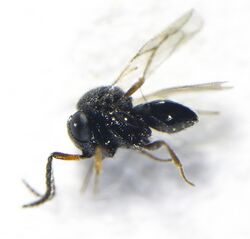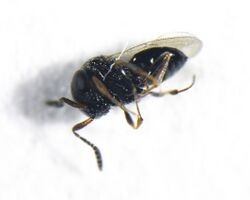Biology:Trissolcus oenone
| Trissolcus oenone | |
|---|---|

| |
| Trissolcus oenone male | |
| Scientific classification | |
| Domain: | Eukaryota |
| Kingdom: | Animalia |
| Phylum: | Arthropoda |
| Class: | Insecta |
| Order: | Hymenoptera |
| Family: | Scelionidae |
| Genus: | Trissolcus |
| Species: | T. oenone
|
| Binomial name | |
| Trissolcus oenone (Dodd, 1913)
| |
| Synonyms | |
| |
Trissolcus oenone is a parasitoid wasp in the family Platygastridae, native to Australia and New Zealand. It parasitises the eggs of stink bugs (Pentatomidae), but little is known about its biology.
Description
Trissolcus oenone is a small black wasp, 1–2mm in length (depending on host), and shares many morphological similarities with other Australian Trissolcus species.[1] The New Zealand population can generally be separated from other New Zealand Trissolcus species based on the colour of parasitised eggs, and the colour of the legs and antennae.[2] Pentatomid eggs parasitised by Trissolcus oenone develop a black ring near the top of the egg, whereas those parasitised by T. basalis turn almost entirely black. Adult specimens of T. oenone have black patches on the bases of the legs, while T. basalis legs are uniformly orange.[2]
Ecology
Trissolcus oenone is very common in Australia where it is known to parasitise the eggs of Biprorulis bibax, Cermatulus nasalis, Cuspicona privata, Nezara viridula, Oechalia consocialis, Oechalia schellenbergii, and Plautia affinis.[1][3][4] In New Zealand, T. oenone has been recorded from native species Cermatulus nasalis and Glaucias amyoti, and the introduced species Cuspicona simplex, Dictyotus caenosus, Monteithiella humeralis, and Oechalia schellenbergii.[2][5] Female parasitoids lay an egg into a host egg, and the emerging wasp larva develops inside the host egg. The length of development depends on the host species and temperature.[6]
References
- ↑ 1.0 1.1 Johnson, N. F. (1991). "Revision of Australasian Trissolcus species (Hymenoptera : Scelionidae)" (in en). Invertebrate Systematics 5 (1): 211. doi:10.1071/IT9910211. ISSN 1445-5226. https://zenodo.org/record/23957/files/633.pdf. Retrieved 2020-07-08.
- ↑ 2.0 2.1 2.2 Martin, Nicholas (2018). "Native shield-bug egg parasitoid - Trissolcus oenone". https://nzacfactsheets.landcareresearch.co.nz/factsheet/InterestingInsects/Native-shield-bug-egg-parasitoid---Trissolcus-oenone.html.
- ↑ "Trissolcus oenone". https://bie.ala.org.au/species/urn:lsid:biodiversity.org.au:afd.taxon:6f412533-5a7b-4bd2-92ea-c301e51a1401#overview.
- ↑ Coombs, M; Khan, Sa (June 1998). "Population levels and natural enemies of Plautia affinis Dallas (Hemiptera: Pentatomidae) on raspberry, Rubus idaeus L., in south-eastern Queensland" (in en). Australian Journal of Entomology 37 (2): 125–129. doi:10.1111/j.1440-6055.1998.tb01559.x. http://doi.wiley.com/10.1111/j.1440-6055.1998.tb01559.x. Retrieved 2020-07-10.
- ↑ Cumber, Ron A. (1964). "The egg-parasite complex (Scelionidae: Hymenoptera) of shield bugs (Pentatomidae, Acanthosomidae: Heteroptera) in New Zealand". New Zealand Journal of Science 7 (4): 536–554. https://bugz.ento.org.nz/detail/350b0ae5-b6e8-45c8-b768-4fec52b9716b. Retrieved 2023-11-23.
- ↑ James, David G.; Warren, Glen N. (1991). "Effect of temperature on development, survival, longevity and fecundity of Trissolcus oenone Dodd (Hymenoptera: Scelionidae)" (in en). Australian Journal of Entomology 30 (4): 303–306. doi:10.1111/j.1440-6055.1991.tb00441.x. ISSN 1326-6756.
Wikidata ☰ Q14495751 entry
 |


